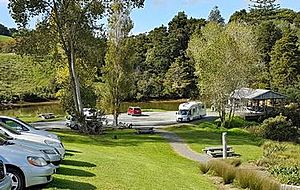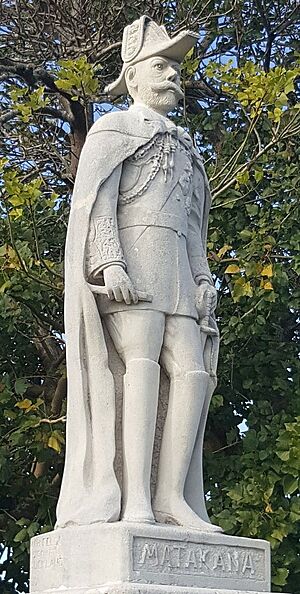Matakana facts for kids
Quick facts for kids
Matakana
|
|
|---|---|

Matakana Wharf Reserve and Matakana River viewed from the village junction.
|
|
| Country | New Zealand |
| Region | Auckland Region |
| Ward | Rodney ward |
| Local board | Rodney Local Board |
| Subdivision | Warkworth subdivision |
| Electorates |
|
| Area | |
| • Total | 1.60 km2 (0.62 sq mi) |
| Population
(June 2023)
|
|
| • Total | 660 |
| • Density | 413/km2 (1,068/sq mi) |
Matakana is a small town in the Auckland Region of New Zealand. It is located in the Rodney Ward, about 9 kilometers (5.5 miles) southwest of Warkworth. Other nearby towns include Snells Beach to the south, Ōmaha to the east, and Leigh to the northeast. The Matakana River flows through the town and into Kawau Bay.
The area around Matakana is famous for its many vineyards and breweries. They produce different types of wine like pinot gris, merlot, and syrah. Matakana offers a taste of rural life with craft shops, markets, and cozy cafes. It's a popular spot for people from Auckland to visit, as it's only about an hour's drive away.
Contents
Discovering Matakana's Past
The first people to live in the Matakana area were Māori from the Ngāti Raupo hapū (family group). This group was part of the larger Te Kawerau and Ngāti Manuhiri tribes. In the 1840s, the Crown (the government) began buying land in the area.
After this, loggers arrived to cut down the huge kauri trees and other timber. By 1852, George Darroch had a large shipyard that built wooden ships for over 50 years. A sawmill opened on the Matakana River in 1853. People also harvested flax from the area.
Matakana's first public building, a school and church, opened in 1864. By 1881, most of the native forests had been cut down. Farming then became the main activity, especially growing fruit. The Matakana Dairy Factory opened in 1902 and is now a shop. A factory that made shark oil also operated here from 1905. Electricity came to Matakana in 1936, bringing modern changes to the town.
Matakana War Memorial
The Matakana War Memorial is an important landmark that remembers 13 local men who died in the First World War. It was officially revealed on April 24, 1920, by Joseph Gordon Coates. This made it the first war memorial statue unveiled in New Zealand after the war ended in 1918.
After the memorial was restored, another plaque was added on April 24, 2000. This plaque honors seven more men from the area who died in the Second World War. The memorial features an early statue of King George V. It was carved from Oamaru stone by a New Zealand artist named William Henry Feldon.
Instead of ordering a statue from overseas, the people of Matakana chose a local artist. Matakana was a small community, but it lost many soldiers in the war. The memorial was placed in a special spot near the wharf, where soldiers were often farewelled.
The local army unit from Matakana was part of the Auckland Mounted Rifles. The artist, William Henry Feldon, was also a leader in this group. The statue shows King George V in his military uniform. In his right hand, he holds a scroll about the King's call for two minutes of silence. In his left hand, he holds a sword, ready for victory.
The statue has been damaged and repaired several times over the years. In 2006, the memorial was moved from its original spot to a nearby area in the Matakana Wharf Reserve. The old spot is now used for the Matakana Toilets.
Matakana's Population
Matakana is considered a rural settlement by Statistics New Zealand. It covers about 1.60 square kilometers. As of 2018, it had an estimated population of 492 people. This means there were about 308 people living in each square kilometer.
In the 2023 New Zealand census, Matakana had a population of 570 people. This was an increase of 78 people since the 2018 census. There were 270 males and 300 females living in 225 homes. The average age of people in Matakana was 48.3 years. About 20.5% of the people were under 15 years old.
Most people in Matakana (92.1%) are of European background. About 7.9% are Māori. English is spoken by almost everyone (97.9%). About 24.2% of the people in Matakana were born outside New Zealand.
When it comes to beliefs, about 30% of people identify as Christian. Most people (59.5%) said they had no religion. Many people in Matakana have a good education. About 25.2% have a university degree or higher. The average income in Matakana was $48,200.
Matakana Diamond Jubilee Park
History of the Park
The Matakana Diamond Jubilee Park first opened in 1897. Before it was a park, there was a horse racing track in Matakana. Horse races and athletic events were held there from about 1870 to 1897. The park was created after the racetrack closed. It was named to celebrate Queen Victoria's 60 years as queen.
When the park first opened, it was used for agricultural shows starting in 1898. It also hosted sports like rugby, cricket, hockey, and tennis. The Matakana Cricket Club moved to the park and was well-known for its Boxing Day cricket matches. Tennis courts were built in the 1920s.
In the early 1960s, an old schoolroom from Kawau Island was moved to the park. It was used by the Scouts and Guides until 2003. The building later fell into disrepair and was burned down by the Matakana Fire Brigade in 2008. Rugby and hockey were played in the park until the 1960s. School children played soccer there during winter until 1996.
The Matakana Pony Club started meeting at the park in 1977. The pony club and other sports clubs shared the park. By 2018, some areas of the park were not in good condition. The Auckland Council helped to improve the park by leveling the ground. The Pony Club also helped by rebuilding their yards closer to their clubhouse.
Future Plans for the Park
The Auckland Council has been asking the community for ideas on how to use Matakana Jubilee Park in the future. They want to make sure the park meets the needs of everyone. They shared different ideas for the park and asked people for their thoughts.
In 2020, an agreement was made to allow the pony club and the wider community to share the park. This helps make sure the park is used by many different groups.
Matakana's Climate
Matakana has a mild climate. Here's a look at the average temperatures and rainfall:
| Climate data for Matakana (1951–1980) | |||||||||||||
|---|---|---|---|---|---|---|---|---|---|---|---|---|---|
| Month | Jan | Feb | Mar | Apr | May | Jun | Jul | Aug | Sep | Oct | Nov | Dec | Year |
| Mean daily maximum °C (°F) | 23.6 (74.5) |
23.6 (74.5) |
22.0 (71.6) |
20.1 (68.2) |
17.3 (63.1) |
15.4 (59.7) |
14.2 (57.6) |
14.9 (58.8) |
16.4 (61.5) |
18.2 (64.8) |
19.8 (67.6) |
21.5 (70.7) |
18.9 (66.1) |
| Daily mean °C (°F) | 19.5 (67.1) |
19.8 (67.6) |
18.7 (65.7) |
16.7 (62.1) |
14.2 (57.6) |
12.5 (54.5) |
11.2 (52.2) |
11.9 (53.4) |
12.9 (55.2) |
14.5 (58.1) |
16.0 (60.8) |
17.6 (63.7) |
15.5 (59.8) |
| Mean daily minimum °C (°F) | 15.3 (59.5) |
16.0 (60.8) |
15.3 (59.5) |
13.2 (55.8) |
11.1 (52.0) |
9.5 (49.1) |
8.1 (46.6) |
8.8 (47.8) |
9.4 (48.9) |
10.7 (51.3) |
12.1 (53.8) |
13.7 (56.7) |
11.9 (53.5) |
| Average rainfall mm (inches) | 69 (2.7) |
113 (4.4) |
103 (4.1) |
121 (4.8) |
144 (5.7) |
155 (6.1) |
141 (5.6) |
164 (6.5) |
119 (4.7) |
103 (4.1) |
102 (4.0) |
95 (3.7) |
1,429 (56.4) |
| Source: NIWA | |||||||||||||
Education in Matakana
Matakana School is a primary school for students in years 1 to 6. It is a coeducational school, meaning both boys and girls attend. As of 2023, the school has about 295 students. Matakana School was first started in 1862.
Events in Matakana
Matakana hosts many different events throughout the year.
- The Matakana Farmers' Market is held every Saturday. You can find fresh local produce and crafts there.
- The Matakana War Memorial holds an ANZAC Day Service at 10 am each year to remember fallen soldiers.
More About Matakana
- Matakana Village website
- Matakana War Memorial Facebook page
- Matakana Cemetery Facebook page
- 1:50,000 map of Matakana
- 1942 one inch map of Matakana



